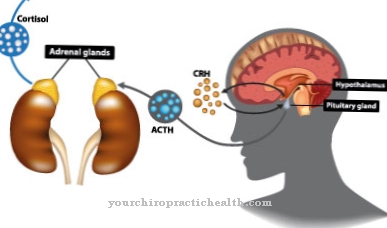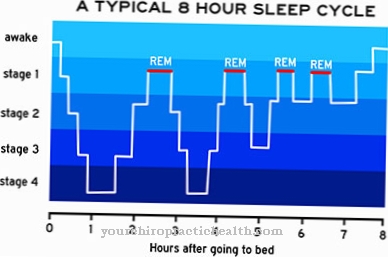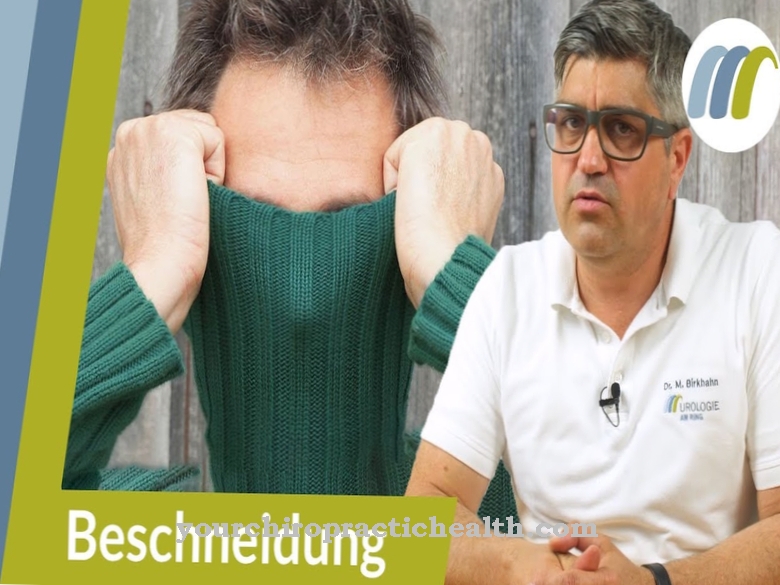The Synesthesia is a symptom that is still largely unknown in the population, a peculiarity in the perception of sensory stimuli. Those affected always experience sensory impressions as a coupling of two or more perceptions.
What is synesthesia?

© braverabbit - stock.adobe.com
The Synesthesia was already described in scientific literature 300 years ago and today we know of famous people affected such as Franz Liszt and Richard Feynman.
Synesthesia did not come into the scientific focus until 1880 with the investigation of visualized numbers; it has only been seriously researched scientifically since 1996.
Affected people experience one or more sensations coupled and as an indissoluble unit. Synesthesia occurs in numerous variants, the most common forms being photisms, the perception of what is heard with colors, geometric shapes or color patterns, and colored hearing, the perception of sensory impressions with colors. Synesthesia is different from one person to the next.
There are various statements about the frequency of the phenomenon, scientists suspect that between 1 in 200 and 1 in 2000 people could be synesthetes. The number of unreported cases could be much higher, because those affected experience their perception as normal and are not aware of their synesthesia.
causes
The majority Synesthesia are based on hereditary causes, which can be proven by two facts: those affected describe their special perception as never been different and synesthesia occurs more frequently in families, around 25% of first-degree relatives can be diagnosed as affected.
Those affected have different nerve connections, so that one sensory stimulus causes two or more scientifically measurable sensations. Synesthesia could be established as a scientific fact and anatomical peculiarity on the basis of these nerve connections, so the sensory impressions are medically real.
Synesthetic perceptions imprint themselves better on the memory than the triggering stimulus, so those affected can remember the color better than the triggering tone. In addition, synaesthetic experiences are involuntary and unconscious and cannot be consciously controlled or stopped by the person concerned. Synesthesia can, however, also occur as misperceptions during hallucinations, triggered by mental illness, epileptic seizures or after the ingestion of hallucinogens.
The causes of synesthesia can be differentiated by their occurrence: While congenital synesthetes describe the sensory impressions with full consciousness in everyday life, hallucinations disrupt any perception.
Symptoms, ailments & signs
Synesthesia is often not recognized as a peculiarity by those affected for a long time, because it is innate and a synaesthetist has always perceived sensory stimuli from his environment in this way. With those affected, different areas of perception are coupled. As a result, they experience two or more different types of perception at the same time as a reaction to a single sensory stimulus.
The most common type of synesthesia is hearing colors: for those affected, each tone has its own color, which is felt when hearing. However, there are many different types of synesthesia. It can affect all senses, hearing, sight, taste, smell and touch. In addition, every synesthesia is unique. The place of perception is difficult to determine and can be inside or outside the body of the synaesthet.
The coupling of the sensory perceptions happens involuntarily and cannot be suppressed. Synaesthesias are usually irreversible: if a synesthet perceives a number in a certain color, then conversely this color does not necessarily have to cause the number to be seen.
Some synaesthetes can achieve above-average memory performance because synaesthetic perceptions are particularly easy to memorize. Hypersensitivity can occur as a further symptom, in which the intense experience leads to a rapid overload of stimuli.Synaesthetes can also be particularly creative.
Diagnosis & course
As described, can congenital Synesthesia can be detected by brain scans. The most important methods for displaying the cross-connections in the brain are functional magnetic resonance imaging (MRT) or positron emission tomography (PET).
The simpler diagnostic method is an assignment test. Test subjects are played with tones of different heights to which they should assign one of several color tables. While those not affected associate light tones with light colors in this test, synaesthetes have their own assignment laws that deviate from this rule, but can explain the choice of assignment for them logically and comprehensibly.
Synesthesia is innate and usually shows a progressive course; many synesthetes report an increase in sensory impressions with advancing age.
In contrast to the congenital synesthesia, the hallucinogenic is not detectable. Only the possibility of occurrence can be determined based on the substances ingested or the illnesses present.
Complications
Because of the many forms of synesthesia, there is no need to talk about complications in general. There are also no complications as a result of treatments, since synesthesia has no disease value and therefore no therapy is necessary. Synaesthetes are most likely to experience complications such that the additional sensation that occurs with a primary stimulus can be unpleasant, which can lead to avoidance of certain stimuli.
For example, hearing a certain sound can lead to a sensory - in this case unpleasant or annoying - sensation. However, these unwanted sensations are very different in different cases of synesthesia and often do not occur.
Complications can also result from ailments that first led to synesthesia. Few possible causes are known here, but strokes and severe traumatic brain injuries are mentioned. Overall, it can be said that synesthesia is usually perceived as pleasant.
Since most synaesthetes do not know their perception differently, no problems arise. Rather, this other form of perception often leads to outstanding performance. Only when "learning" to perceive and mixing several sensory levels can the synaesthet encounter certain problems due to ridicule or rejection.
When should you go to the doctor?
In the case of synesthesia, the affected person is in any case dependent on medical treatment and examination. This disease cannot heal itself, so an examination by a doctor must definitely be carried out. The earlier the disease is recognized, the better the further course. If there is no treatment, the symptoms worsen. A doctor should be consulted for synaesthesia if the person concerned can no longer properly perceive external stimuli and feelings.
This leads to problems with hearing or seeing, which can significantly limit everyday life. Serious symptoms can also arise when tasting or smelling, and a doctor should be consulted. As a rule, a general practitioner can be consulted for synesthesia. Further treatment is then carried out by a specialist. As a rule, this disease does not reduce the life expectancy of the person affected.
Treatment & Therapy
The hallucinogenic Synesthesia is usually treated by treating the underlying disease or by stopping the use of hallucinogens. This is also a preventive measure.
Congenital synesthesia is not actually a disease. On the contrary, many consciously affected see their specialty as an ability and gift. Accordingly, there is no need for therapy of the anatomical peculiarity and there is no possibility of prevention.
Medical research tries today to use synesthesia as a therapy for pain patients. A team of researchers found in experiments with mice that the genes for synesthesia and pain perception are identical. In the mice, pain stimuli did not reach the cerebral cortex, which is responsible for awareness of pain, but rather those brain regions that are responsible for sensory impressions and perceptions. The synaesthetic mice evidently did not feel the pain; they perceived it as an impression of smell or taste.
The aim now is to understand these research results in order to be able to use them to develop new pain medication.
Aftercare
In most cases, those affected have only limited measures or options for follow-up care available with synesthesia, as it is a rare disease. If the disease has been present since birth, it usually cannot be completely cured. Therefore, those affected should consider genetic testing and counseling if they wish to have children to prevent the disease from recurring.
As a rule, it cannot heal independently. Most patients are dependent on a surgical procedure for synesthesia, through which the symptoms can be relieved permanently. After such an operation, strict bed rest should be maintained, with no exertion or physical and stressful activities.
Many of those affected are dependent on the help and support of their own families because of their synesthesia. Psychological support can also prevent the development of depression and other psychological complaints. Contact with other people affected by the disease can also be useful, as this can lead to an exchange of information. In some cases, the disease also reduces the life expectancy of those affected.
You can do that yourself
People who have been diagnosed with synesthesia are highly sensitive to sounds, colors and other stimuli. You are exhausted faster and need time to process the impressions. It is the responsibility of the relatives to treat the person concerned with understanding.
If the child has been diagnosed with synesthesia, it is advisable to contact other affected parents. Through the experience of parents whose child is synaesthetic, the upbringing of one's own child is less stressful. In order to promote the phenomenon as well as possible, suitable special kindergartens or schools must be organized. Although children with synesthesia can participate in normal everyday life, there are often other psychological abnormalities. Therefore, if synesthesia is diagnosed, you should always work with specialists and trained special educators.
In the case of mild synesthesia, the child often has no restrictions at all. Because affected children usually think and act differently than people without synesthesia, patience is always required when dealing with those affected. Good communication at home helps children with synesthesia to process their unique world of thought and to talk to people they trust about them.


.jpg)
























